NOTES ON PLAQUE NAMES
IN COLUMN TWO
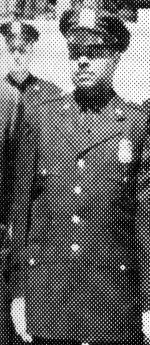 -- "H. Brown," the 1st name entered in the second column of the WWII Honor Roll, possibly matches correctly with the name "Harold Brown" that appears on Page 10 of the Vol. XII No. 3, 1969, issue of Correction Sidelights in a story strangely headlined "Departmental Recognition for Bronx House of Detention of Men Escape Attempt." His name appears in the list of 21 DOC uniformed personnel honored for their roles in thwarting the escape attempt by seven inmates armed with improvised weapons. Correction Officer Harold Brown received Meritorious Service recognition for "his intelligent performance and valuable service."
-- "H. Brown," the 1st name entered in the second column of the WWII Honor Roll, possibly matches correctly with the name "Harold Brown" that appears on Page 10 of the Vol. XII No. 3, 1969, issue of Correction Sidelights in a story strangely headlined "Departmental Recognition for Bronx House of Detention of Men Escape Attempt." His name appears in the list of 21 DOC uniformed personnel honored for their roles in thwarting the escape attempt by seven inmates armed with improvised weapons. Correction Officer Harold Brown received Meritorious Service recognition for "his intelligent performance and valuable service." Page 10 of the May - June - July 1959 issue listed Harold Brown elected as C.O.B. A. Legal Chairman. His DOC assignment then was also the Bronx House.
The image right of C. O. Harold Brown was extracted from a group photo appearing on Page 541 of Progress Through Crisis, Anna M. Kross' report on her 1954 - 1965 tenure as NYC Correction Commissioner. The caption identifies him as COBA 3rd Vice President. The occasion was "Correction Day" ceremonies held April 24, 1964, at City Hall steps. Brian J. Sharkey sent NYCHS an e-mail note that, "Harold Brown was also President of COBA."
Return to Honor Roll list Return to Top of Page
-- "M. Sonn," the 5th name entered in the second column of the WWII Honor Roll, probably matches correctly with the name "Michael Sonn" that appears on Page 16 of the Vol. XII No. 3, 1969, issue of Correction Sidelights in a story headlined "Annual Memorial Mass" His name appears in the list of 26 DOC employees, still in service or retired, who died during the year 1968. The solemn requiem mass was concelebrated
by Tombs Chaplain Fr. Laurence H. Gibney and House of Detention for Women Chaplain Fr. Charles Repole Nov. 16, 1968, in St. Patrick's Cathedral.
Return to Honor Roll list Return to Top of Page
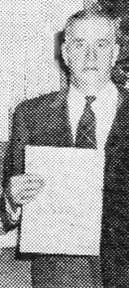 -- "J. McCormack," the eighth name entered in the second column of the WWII Honor Roll, may possibly match with the name "John McCormack," a Correction Officer who was among seven DOC staffers honored January 21, 1959 upon their retirement. His image (left) was extracted from a group photo of the eight retirees that appears above a headline "273 Years of Combined Faithful City Service" on Page 6 of the Jan.-Feb. 1959 Correction Sidelights. The caption states C. O. McCormack served 31 years and 6 months. -- "J. McCormack," the eighth name entered in the second column of the WWII Honor Roll, may possibly match with the name "John McCormack," a Correction Officer who was among seven DOC staffers honored January 21, 1959 upon their retirement. His image (left) was extracted from a group photo of the eight retirees that appears above a headline "273 Years of Combined Faithful City Service" on Page 6 of the Jan.-Feb. 1959 Correction Sidelights. The caption states C. O. McCormack served 31 years and 6 months.
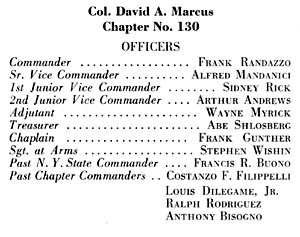 In the same DOC newsletter issue, most of Page 11 was devoted to describing the Col. David A. Marcus Chapter of the Disabled American Veterans. It was founded in 1952 by Francis R. Buono whose name is listed on the Rikers WII Honor Roll plaque. Buono was NY State Commander of the DAV at the time the DOC chapter was formed and named in honor of former DOC Commissioner "Mickey" Marcus. For more about Marcus' storied career in peace and war, click the scanned image (above right) of the newsletter's list of the DOC DAV chapter's 1959 officers. In the same DOC newsletter issue, most of Page 11 was devoted to describing the Col. David A. Marcus Chapter of the Disabled American Veterans. It was founded in 1952 by Francis R. Buono whose name is listed on the Rikers WII Honor Roll plaque. Buono was NY State Commander of the DAV at the time the DOC chapter was formed and named in honor of former DOC Commissioner "Mickey" Marcus. For more about Marcus' storied career in peace and war, click the scanned image (above right) of the newsletter's list of the DOC DAV chapter's 1959 officers.
Return to Honor Roll list Return to Top of Page
-- "J. J. Clancy," the 13th name entered in the second column of the WWII Honor Roll, possibly matches correctly with the name "John Clancy," an entry in the 1960 DOC annual report In Memoriam list. John Clancy was cited as having become a Correction Officer Oct. 10, 1929. His assignment was given as the Brooklyn House of Detention. His date of death was listed as March 30, 1960.
Return to Honor Roll list Return to Top of Page
-- "H. G. Doerfler," the 16th name entered in the second column of the WWII Honor Roll, probably matches correctly with the name "Henry Doerfler" that appears on Page 14 of the Aug. - Oct. 1966 issue of Correction Sidelights in a story headlined "28th Annual Memorial Mass." His name appears in the list of 23 "members of the Department of Correction . . who have died since the last Memorial Mass." The list included Rabbi Abraham Burstein who had been a DOC chaplain 31 years. The solemn requiem mass was offered Nov. 12, 1966, in St.Joseph's Church, 371 Avenue of the Americas, Manhattan. The mass was sponsored by the DOC Catholic Guild.
Return to Honor Roll list Return to Top of Page
-- "F. R. Buono," the 19th name entered in the second column of the WWII Honor Roll, 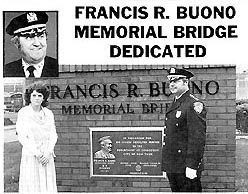 almost certainly matches correctly with the name "Francis R. Buono ," the Supervising Warden for whom the Rikers Island bridge is named. The Buono name appears in more than a dozen places among the DOC history pages on this web site.
This photo (right), from the June 1978 issue of the DOC newsletter The Pen, shows Beth Ann Buono, his daughter, with Commissioner Ciuros at the memorial ceremonies for the Rikers bridge dedication in honor of Buono, C-76's first warden. The image includes an insert head-and-shoulders thumbnail photo of Buono. almost certainly matches correctly with the name "Francis R. Buono ," the Supervising Warden for whom the Rikers Island bridge is named. The Buono name appears in more than a dozen places among the DOC history pages on this web site.
This photo (right), from the June 1978 issue of the DOC newsletter The Pen, shows Beth Ann Buono, his daughter, with Commissioner Ciuros at the memorial ceremonies for the Rikers bridge dedication in honor of Buono, C-76's first warden. The image includes an insert head-and-shoulders thumbnail photo of Buono.
Return to Honor Roll list Return to Top of Page
-- "W. A. Ball," the 25th name entered in the second column of the WWII Honor Roll,  almost certainly matches correctly with the name "Walter Ball," who eventually became a Deputy Warden with more than 29 years of DOC service. He had served two years with the New York State Department of Correction. Ball was appointed a Captain in 1948; Assistant Deputy Warden in 1956; and Deputy Warden in 1960. He was posted in command of the Transportation Division in 1963. He had a distinguished U.S. Army war record during World War Il with the Father Duffy Rainbow Division. almost certainly matches correctly with the name "Walter Ball," who eventually became a Deputy Warden with more than 29 years of DOC service. He had served two years with the New York State Department of Correction. Ball was appointed a Captain in 1948; Assistant Deputy Warden in 1956; and Deputy Warden in 1960. He was posted in command of the Transportation Division in 1963. He had a distinguished U.S. Army war record during World War Il with the Father Duffy Rainbow Division.
This photo (above), like the bio information outlined here about Ball, comes from the Summer 1968 issue of the DOC newsletter Correction Sidelights. Deputy Warden Ball was a member of the Professional Association of Public Executives; Father Duffy Chapter, Rainbow Division Veterans; Disabled American Veterans, Col. David A. Marcus Post; American Legion Brogan Post; Catholic Guild, Department of Correction; and the St. Joseph's Holy Name Society.
Return to Honor Roll list Return to Top of Page
-- "G. Rothaizer," the 26th name entered in the second column of the WWII Honor Roll, was the subject of the following email message received from his son, Joel:
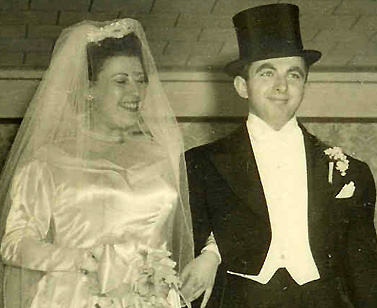 Hello. I just tried a new search engine and put in our last name, Rothaizer, and found your Correction History site's Rikers Island Honor Roll page that includes our father, George Rothaizer (no one else has that last name).
Weíd like to put in a photo and bio for him. Iíve attached a picture of my father and motherís wedding.
George Rothaizer was born in Poland in 1916, and came to the U.S. with his family around 1918.
After WWII he used the GI Bill to become an accountant, and then went to St. Johnís Law School in the evenings to become an attorney.
He died suddenly of a heart attack in 1961. He was a very good and loving husband, father and friend.
He died when I was eight, and I didnít even know he worked at Rikers Island (although his sister, now 95, confirmed it).
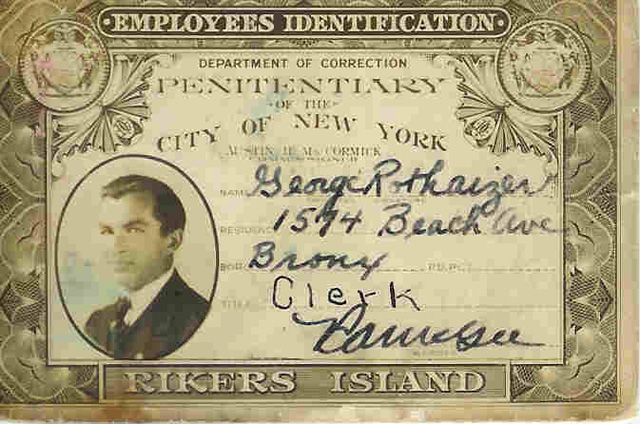 Look what I found! [His Rikers ID card.] Look what I found! [His Rikers ID card.]
Thanks.
Joel Rothaizer & Shoshana Rothaizer
[Webmaster Note: If you click the George Rothaizer Rikers Island ID card, you will see a larger size image of it and may more clearly notice two things about it:
Austin H. MacCormick's name printed as Correction Commissioner under "City of New York" and the signature of R. A. McGee above "Rikers Island.".
In late April 1935, even before construction of the Rikers Island Penitentiary was fully completed, MacCormick's selection of Richard A. McGee to serve as its first warden became known when the latter submitted his resignation as supervisor of education at the Northeastern Federal Penitentiary in Lewisburg, Pa., a post he took Jan. 1, 1933 after 18 months as education supervisor at the federal penitentiary in Leavensworth, Kan.
Before becoming NYC DOC Commissioner in 1934, MacCormick served as assistant director of the federal Bureau of Prisons and had initiated sweeping inmate schooling reforms. Commissioner MacCormick envisioned the new Rikers facility as incorporating a variety of educational, vocational training, rehabilitation and psychiatric services into its program.
When David "Mickey" Marcus, who had been Deputy Commissioner, succeeded MacCormick as DOC Commissioner in April 1940, Warden McGee became Deputy Commissioner. A WWI Marine veteran, he held two university degrees, authored penology textbooks, taught at CCNY, had headed the American Jail Association and edited its journal. In December 1941, McGee left NYC service to accept a position as Washington State Supervisor of Public Institutions, including four correctional facilities. He later headed California's state prison system. The Richard A. McGee Correctional Training Center located in a suburb south of Sacramento is named in his honor.]
Return to Honor Roll list Return to Top of Page
-- "H. Leis," the 27th name entered in the second column of the WWII Honor Roll, probably matches correctly with the name "Herman Leis," mentioned in a story headlined "St. George Association Election Results" that appears on Page 5 of the November 1957 of Correction Sidelights. The story, one of a series about the various department organizations, noted the DOC group was organized in 1940, the 10th chapter formed under the banner of the St. George Association of the U.S.A. At that time, C. O. Thomas Orchard (see his note above) was elected the DOC chapter's first president. The 1957 slate of chapter officers included Brooklyn House of Detention for Men Fingerprint Technician Herman Leis identified as the chapter's "historian."
Return to Honor Roll list Return to Top of Page
NOTES ON PLAQUE NAMES
IN COLUMN THREE
-- "M. J. Kearney," the 2nd name entered in the third column of the WWII Honor Roll, possibly matches correctly with the name "Mark Kearney" that appears on Page 8 of the March - April 1959 issue of Correction Sidelights in a caption below a photo which accompanied an article headlined "Annual Catholic Guild Scholarship Examination." The photo shows 16 children taking the exam March 31, 1959, in Room 1407 at 100 Centre St., Manhattan. Among them is listed Salley Kearney, daughter of Correction Officer Mark Kearney of the Transportation Division.
Return to Honor Roll list Return to Top of Page
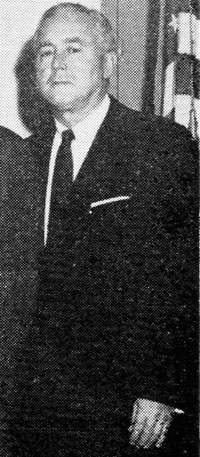 -- "J. M. Walsh," the 6th name entered in the third column of the WWII Honor Roll, almost certainly matches correctly with the name "Joseph M. Walsh," an Assistant Deputy Warden listed with the Analysis and Research Division in a departmental organizational insert in the July 1957 Correction Highlights, the first DOC newsletter in the Anna M. Kross era (and perhaps the first ever for the agency). -- "J. M. Walsh," the 6th name entered in the third column of the WWII Honor Roll, almost certainly matches correctly with the name "Joseph M. Walsh," an Assistant Deputy Warden listed with the Analysis and Research Division in a departmental organizational insert in the July 1957 Correction Highlights, the first DOC newsletter in the Anna M. Kross era (and perhaps the first ever for the agency).His unit -- that, it so happened, produced the newsletter -- was situated at the Central Office, then located at 100 Centre St., Manhattan. The publication changed its name to Correction Sidelights after a few issues because another NYC municipal agency was already using "Highlights" in the name of its newsletter.
On Page 8 of the March - April 1958 issue of Correction Sidelights appears a photo of 8 people at an Employee Suggestion Program awards ceremony, including Commissioner Kross and Director of Operation Anthony Principe. The image (right) of Joseph M. Walsh was extracted from that group photo, Its caption identified him as an Assistant Deputy Warden, member of the DOC Suggestion Program (Analysis & Research Division).
Return to Honor Roll list Return to Top of Page
-- "E. W. Smith," the 17th name entered in the third column of the WWII Honor Roll, may possibly match correctly with the name "Edgar Smith," a DOC captain who died Jan. 27th, 1955. He had joined the Department Dec. 31, 1933. His name, rank, date of DOC appointment, and his date-of-death were noted in an "Im Memoriam" 1954-1957 listing that appeared in Commissioner Kross' 1957 annual report.
Return to Honor Roll list Return to Top of Page
 -- "T. J. Orchard," the 24th name entered in the third column of the WWII Honor Roll, almost certainly matches correctly with the name "Thomas Orchard," secretary of the DOC Masonic Club in early 1960.
-- "T. J. Orchard," the 24th name entered in the third column of the WWII Honor Roll, almost certainly matches correctly with the name "Thomas Orchard," secretary of the DOC Masonic Club in early 1960.
His image right was extracted from a group photo of seven people among those participating in the DOC Masonic Club receiving its charter from the National league of Masonic Clubs Feb. 5, 1960 at the Boulevard Restaurant, Rego Park, Queens. The picture appeared on Page 11 of the Jan.-Feb.-March 1960 issue of the DOC newsletter Correction Sidelights. His assigned facility was identified as the Queens House of Detention for Men. A story about the DOC Masonic Square Club election of officers reported, on Page 9 in the Jan. - March 1964 issue, that Thomas J. Orchard was elected club president.
Return to Honor Roll list Return to Top of Page
 -- "V. C. Traut," the 26th name entered in the third column of the WWII Honor Roll, almost certainly matches correctly with the name "Vincent Traut," who was sworn in as an Assistant Deputy Warden by Commissioner Anna M. Kross. He and five others were sworn in as ADWs, along with five captains, in promotion ceremonies held Jan. 22, 1964 at the Central Office, 100 Centre St., Manhattan. This image (left) was extracted from the swear-in group photo that accompanied the promotions story on Page 10 of the Jan.- March 1964 issue of Correction Sidelights. -- "V. C. Traut," the 26th name entered in the third column of the WWII Honor Roll, almost certainly matches correctly with the name "Vincent Traut," who was sworn in as an Assistant Deputy Warden by Commissioner Anna M. Kross. He and five others were sworn in as ADWs, along with five captains, in promotion ceremonies held Jan. 22, 1964 at the Central Office, 100 Centre St., Manhattan. This image (left) was extracted from the swear-in group photo that accompanied the promotions story on Page 10 of the Jan.- March 1964 issue of Correction Sidelights.
Return to Honor Roll list Return to Top of Page
NOTES ON PLAQUE NAMES
IN COLUMN FOUR
-- "C. A. Davis," the 1st name entered in the fourth column of the WWII Honor Roll, 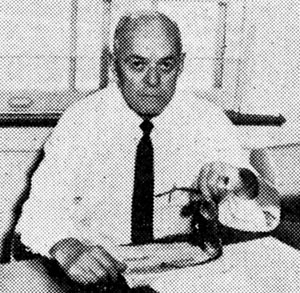 matches correctly with the name "Clinton A. Davis," the Rikers senior stationary engineer who was the subject of a profile article featured on Page 8 in the No. 1 Vol. XII issue of Correction Sidelights in 1958. matches correctly with the name "Clinton A. Davis," the Rikers senior stationary engineer who was the subject of a profile article featured on Page 8 in the No. 1 Vol. XII issue of Correction Sidelights in 1958.
The essay noted Davis' job "in charge of steam and electrical generation, plumbing and sewage system" and general "upkeep of the physical plant at Rikers Island" meant that he "has been anything but stationary for the past 33 years of service to the Department of Correction."
He came to the island in 1935 to install Rikers Penitentiary's locking devices and was persuaded by DOC Chief Engineer Karl Jausly to join DOC maintenance staff. Cliff served in U.S. Navy Seabees three and a half years in the South Pacific during WWII. The image (above left) accompanied the article.
Return to Honor Roll list Return to Top of Page
-- "M. O'Donnell," the 5th name entered in the fourth column of the WWII Honor Roll, probably matches correctly with the name "Martin O'Donnell" that appears on Page 743 of Progress Through Crisis, Anna M. Kross' report on her 1954 - 1965 tenure as NYC Correction Commissioner. The Martin O'Donnell name appears as an entry in a list of 1965 retirements. His rank was given as Correction Officer; his date of DOC appointment, Jan. 1, 1935; his date of retirement, August 30, 1965; his last assignment, Rikers Island (Adult). The parenthetical note was intended to identify which inmate population on Rikers Island he was assigned to, adult or adolescent.
Return to Honor Roll list Return to Top of Page
NOTES ON PLAQUE NAMES
IN COLUMN FIVE
-- "A. Sandarga," the 4th name entered in the fifth column of the WWII Honor Roll, almost certainly matches correctly with the name "Anthony Sandraga" that appears on Page 3 of the Nov. - Dec. 1964 issue of Correction Sidelights in a story headlined "Personnel Honored for Long Service." His name appears in the list of 19 DOC uniformed and civilian employees at the Tombs (Manhattan House of Detention for Men) whose combined DOC service totaled 512 years. The average was about 27 years. The story did not specify individual ranks or job titles.
Return to Honor Roll list Return to Top of Page
|
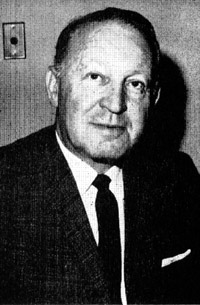
Milton Kleinbegan his DOC career in 1929 as a C. O. and ended it in 1969 as warden, with a 26-month time-out in General Channault's 74th Fighter Squad (the famed Flying Tigers). He entered the Army as a Private and was discharged, with many military honors, as a 2nd Lieutenant, according to a retirement story in Vol. XII No. III 1969 of Correction Sidelights. When Klein retired in 1969, he had been a warden 22 years. |
|
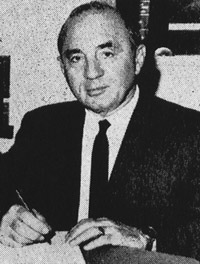
Henry J. Noblewho retired from the agency in Nov. 1969 was credited with 33 years of DOC service. According to a retirement story in Vol. XII No. III 1969 issue of Correction Sidelights, he then became a full-time jail administration consultant with the National Sheriffs Association. With B. S., M. A. and M. B. A. degrees, Noble was named director of DOC's Correctional Training Center, including the Academy, in 1964 and developed the correctional curriculum at John Jay College. A member of the National Guard from 1923, Noble served on active duty in the Army for a decade (1940-50). While a warden, he held the retired reservist rank of Lt. Col. |
|
NOTES ON NAMES NOT ON PLAQUE
Here are some background notes on just a few of the likely many DOC WWII veterans whose Correction careers had been put on hold during their military service in that global conflict but whose names do not happen to be among the 100 listed on the Rikers Island WWII Honor Roll.
These not-on-the-plaque names are presented simply as a few examples to show that the number of DOC employees who enlisted or were drafted into the U. S. Armed Forces during WWII exceeded the 100 names on the Rikers WWII Honor Roll.
As with many local honor rolls erected by communities all across the country early in World War II, the Rikers Island honor roll names evidentially were added as the men enlisted or were drafted while the war was waged, year after year. Apparently those who designed the Rikers Island honor roll mistakenly believed they had allowed sufficient room for whatever names were to be added later.
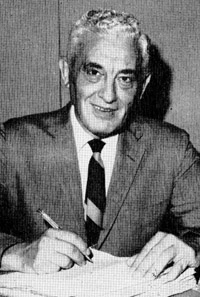
Milton Rothwas warden of the Rikers Island Reformatory when he died of a heart attack Nov. 5, 1968. Roth had joined DOC in 1933 as a psychologist and became a C. O. in 1938.
As a Captain in Army Military Intelligence, Roth served on active duty from 1941 to 1948.
According to his obituary in Vol. XII No. III 1969 of Correction Sidelights, he was a member of General Douglas MacArthur's personal staff, was fluent in Japanese, and for three years ruled a Japanese province as its de facto governor. He retired as a Lt. Col. in the Army Reserves. Back with DOC, Roth became a Captain in 1952, ADW in 1957 and Deputy Warden in 1962. |
|
Perhaps they were hopefully optimistic that the number of names would not exceed the 100 entry spaces which the plaque size and format allowed.
One can surmise that, once the plaque had no more room for additional names, some less permanent name display was devised such as a typed list posted below it, a paper list inevitably lost during the post-war years.
Had the plaque been produced after the successful completion of the war, presumably it would have been designed in a size and format to include all the names. As the examples here suggest, that was not likely the case.
Another reason for believing the names appearing on the Rikers Island World War II plaque had been added in periodic increments as that conflict continued is the fact that they are not in any alphabetical order.
Had the names been entered after the war ended, the very strong likelihood exists that they would have been listed alphabetically so as to show no personal partiality in the order of name placement.
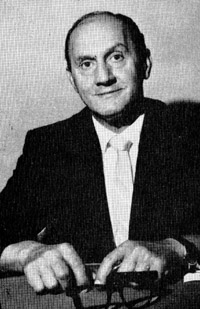
Albert N. Nenna was warden of the Tombs, aka Manhattan House of Detention for Men, when he died Nov. 3, 1968, after a two-month illness. Nenna began his DOC career in 1939 as the C. O. and was promoted to Captain in 1948, three years after returning to Correction following WWII service as an Army Air Force radio operator and machine-gunner. His plane was shot down over Germany while on his 19th mission.
Nenna was a POW from Sept. 19th, 1944 to may 3, 1945. He earned four battle stars and three oak leaf clusters. According to his obituary in Vol. XII No. III 1969 issue of Correction Sidelights, he was promoted twice in 1956-- first to ADW and three months later to Deputy Warden. Commissioner George McGrath appointed him warden in October 1966. |
|
Whether the entries were rigidly time-sequential -- that is, based on when the person enlisted or was drafted -- is difficult to tell without more data than is available. Batches of names were probably placed on the plaque as the number at hand warranted taking up that task.
Also difficult to determine is how rigidly the plaque's phrase "Rikers Island employees" was applied. If literally only Rikers Island staffers' names were entered but not DOC staffers at Center Office, the court pens, the district jails, the reformatories in Orange County, the Tombs and the other borough houses of detention, then perhaps the Rikers plaque planners' notion that not more than 100 name spaces would be needed may seem more understandable.
But then where are the non-Rikers facilities WWII Honor Rolls?
That only Rikers would have had such an Honor Roll display seems improbable.
So are there other DOC WWII Honor Rolls that have survived the ravages of time or is JATC's the only one remaining?
If anyone reading this knows of another such DOC WWII Honor Roll or recalls seeing it or hearing about it, please e-mail the information to the webmaster. Or if you know someone whom you think might have seen another such DOC WWII Honor Roll, please ask him or her about it.
These observations about names on the Rikers plaque and about names not on the Rikers plaque focus on those DOC staffers whose Correction careers had been interrupted by their military service but who resumed those DOC careers afterwards. The research did come across names of WWII vets who began their DOC careers after the war. But those names were not on the plaque, a result entirely consistent with the working theory that, before the war ended, the plaque had been filled up with the maximum number of names it could accommodate.
|
|
|
|

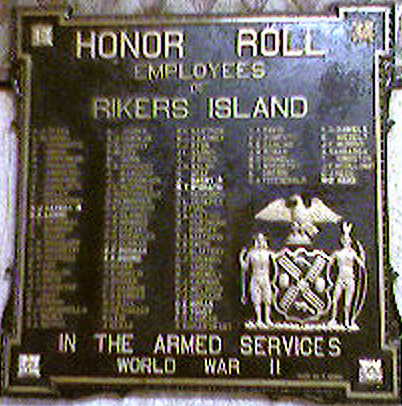 Rikers Island
Rikers Island